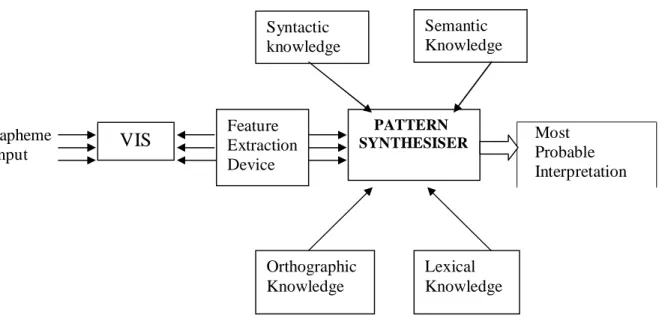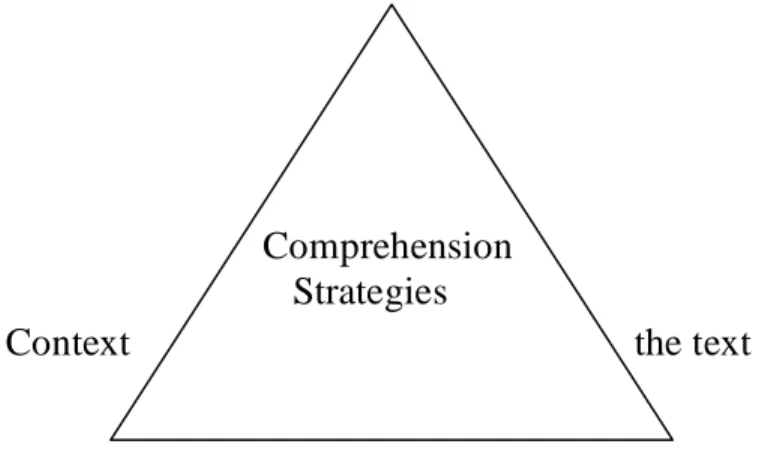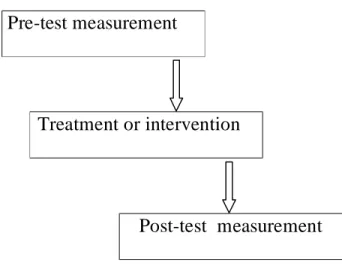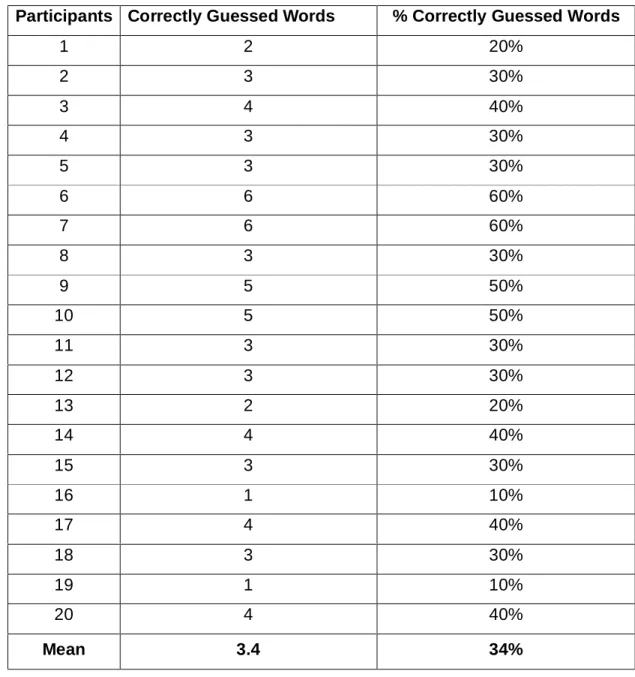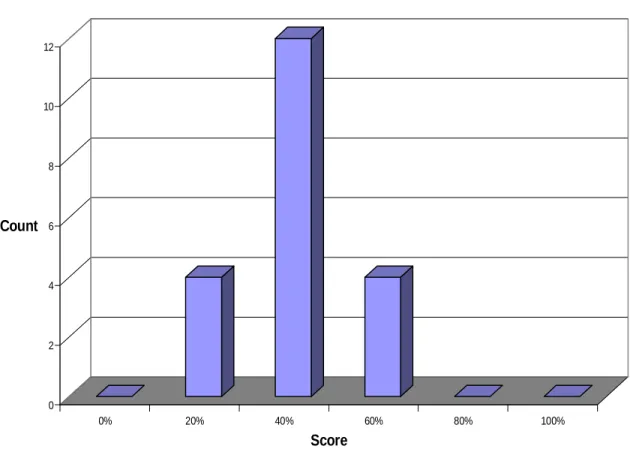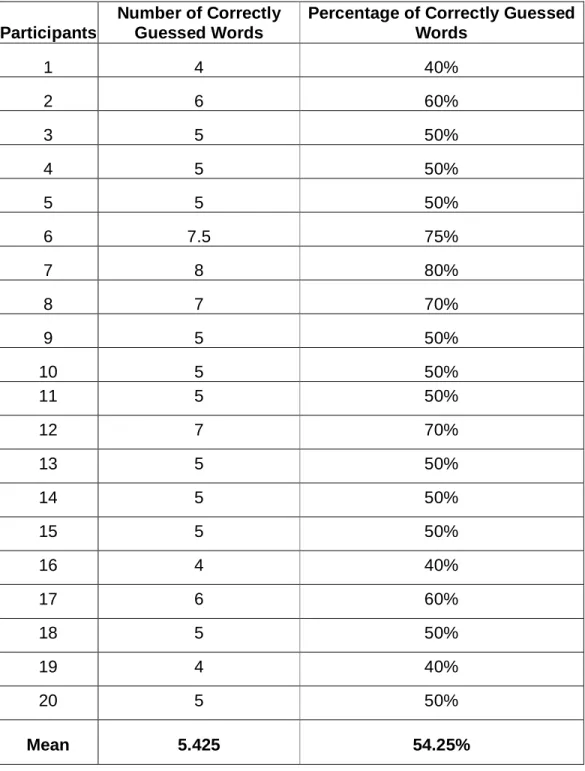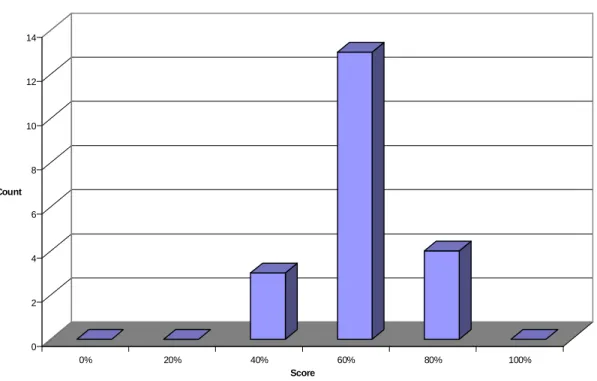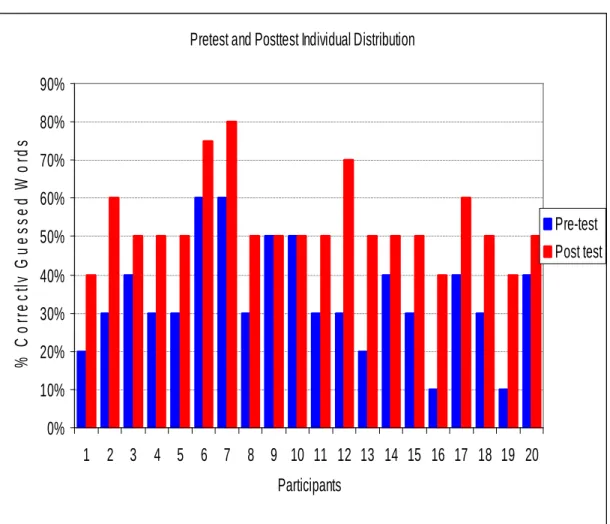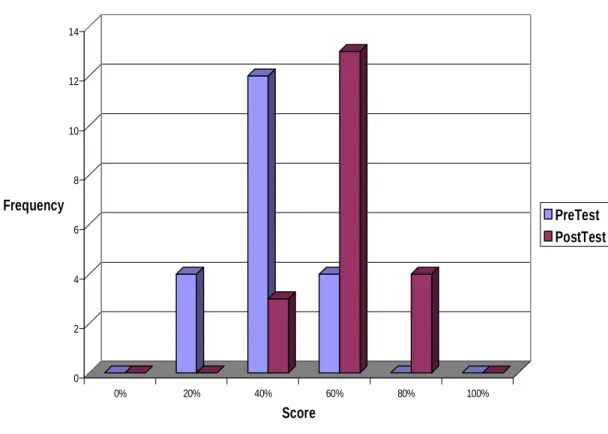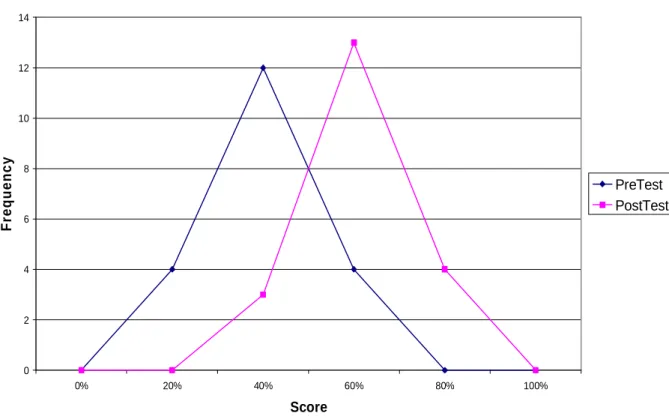The People's Democratic Republic of Algeria
Ministry of Higher Education and Scientific Research
Mentouri University, Constantine
Faculty of Letters and Languages
Department of Foreign Languages
Using Contextual Clues in Guessing
Foreign Language Vocabulary Meaning
The Case of First-Year LMD Students
A Dissertation Submitted in Partial Fulfilment of the Requirements for the Magistere Degree in Teaching English as a Foreign Language
Submitted by Sebti Rahmani Supervised by: Dr. Ahmed Moumene
Board of Examiners
:Chairman: Prof. Hacene SAADI Prof. University of Constantine Supervisor: Dr. Ahmed MOUMENE Mc. University of Constantine Member: Dr. Said KESKES Mc. University of Setif
Dedication
To the memory of my mother
To my father for his understanding and support To my wife and my children
Acknowledgements
I wish to express my gratitude to Dr. Ahmed Moumene, the supervisor of this research work, for his encouragement and guidance throughout my post graduate studies.
I would also like to acknowledge and express my appreciation to Professor Lamine Kouloughli for his assistance and advice.
I am indebted to my friend, the journalist, Hamid Bouchoucha who inspired me the idea of having post-graduate studies and who encouraged me a lot.
My thanks also go to all my teachers in general, and to the board of examiners who accepted to read this research work namely Prof. Hacene Saadi, Dr. Ahmed Moumene and Dr. Said Keskes.
Abstract
The present study is an attempt to prove that training learners in using the inferencing strategy for unknown words while reading is possible. We started our research work with an introduction of the topic of reading and the different reading theories together with the reading purposes to pave the ground for the discussion of vocabulary strategies. These strategies are divided into two categories: Teacher –centered strategies where the teacher is the main actor; and learner-centered strategies which focus on the learners’ independent strategies. The strategy which is at the center work is guessing vocabulary meaning from context or the guessing from context strategy. In our study, we have tried to answer two main interrelated research questions. The first is whether the guessing from context strategy training is possible or not? The second concerns the degree at which the learners’ rate of giving correct guesses can be improved after training?
To answer these questions, we adopted a pre-experimental research design where one group of students is pretested, trained in using the strategy and then post-tested. These participants are first year LMD students of English at the University of Mentouri in Constantine. The findings of this study confirm the results of previous research on training
students in using contextual clues for guessing vocabulary meaning which show that considerable gains take place on the part of learners (Ames,1966, Liu and Nationm1984); thus, a strong confirmation of the possibility of strategy training.
The findings of this research work have various pedagogical implications, particularly for students who are doing extensive readings. In this case, readers find it difficult to use the dictionary to check every word. In addition, the teacher is not always available for help, therefore, the best way left to overcome this problem is using the guessing from context strategy.
List of Abbreviations
FL: Foreign language
GFCs: Guessing from Context strategy L1: First language
LMD: License Master Doctorate TL : Target language
List of Diagrams, Figures and Tables
Diagrams
Diagram 1 Graphic Representation of the Interactive Model…….……. 22
Diagram 2 Knut and Jones’ Comprehension Model ……….… 31 Diagram 3 Pre-experimental Research Design……….… 82
Diagram 4 Overview of Procedures………..… 82
Figures
Figure 1: Pretest Scores Distribution………….……….…...…87 Figure 2: Posttest Scores Dstribution……… .………..……. 92 Figure 3: Individual Scores in the Pretest and the Posttest….……... 93 Figure 4: Global Scores Distribution in the Pretest and the Posttest… 94 Figure 5: Pretest and Posttest Scores Distribution..………... 95 Figure 6: Improvement Distribution ……….…… 98
Tables
Table 1: What is Involved in Knowing a Word………..…… 39-40 Table 2: Kinds of Contextual Clues………..……….. 61-62 Table 3: Pretest Scores……….………. 86 Table 4: Posttest Scores……….………91 Table 5: Participants’ Improvement ………/…… 97
Table of Contents
Dedications
……….. i
Acknowledgements ……….... ii
Abstract……… iii
List of Abbreviations……….. v
List of Diagrams, Figures and Tables ………. vi
Table of Contents ………... vii
Introduction ………..… 1 Chapter I: Reading……….… 6 Introduction ……… 6 1.1 Definition of Reading ………...……….. 8 1.2 Reading Materials………...… 11 1.3 Reading Purposes…... 12
I.4 Models of the Reading Process ………... … 14
1.4.1 Definition of a Model……… 15
1.4.2 The Bottom-Up Model……….... 15
1.4.3 The Top-Down Model……….… 17
1.4.4 The Interactive Model……… …. 20
I.5 Reading Strategies………. 23
I.6 Types of Reading………. 25
Conclusion……….. 27
Chapter II: Reading and Vocabulary Issue ……… 28
Introduction…….………. 28
2.2 Impediments of Reading Comprehension……… 31
2.2.1 Word-Level Deficits……… 32
2.2.2 Sentence Level Deficits……… 33
2.2.3 Discourse Level Deficits………. 33
2.2.4 Cognitive Abilities………. 34
2.2.5 Prior Knowledge………. 34
2.3 The Vocabulary Issue ………. 35
2.3.1 Vocabulary Knowledge……….…… 37
2.3.2 Word Mastery……….… 37
2.3.3 Vocabulary Size and Coverage…………... 40
2.3.4 Importance of Vocabulary in Reading Comprehension.….42 2.3.5 Purposes of Teaching Vocabulary ……….… 43
2.4 Word Difficulties………. 44
2.5 Vocabulary Strategies ……….…………. 45
2.5.1Teacher- Centred Strategies……….………….. 47
2.5.1.1 Unplanned Vocabulary Teaching…………..…... 47
2.5.1.2 Planned Vocabulary Teaching……….…. 48
2.5.1.3 Criteria for Choosing Words for Instruction…….. 49
2.5.2 Learner-centred Strategies……….….. 50
2.5.2.1 Word ignorance……….….. 51
2.5.2..2 Dictionary Use……….…. 53
Conclusion……….… 56
Chapter III: The Guessing from Context Strategy ……….…. 57
Introduction………... 57
3.1 Definition of the GFC Strategy………. 58
3.2 Kinds of Contextual Clues………. 60
3.3 Rationale for the GFC Strategy……….. 68
3.5Training Learners to Use the GFC Strategy ………..….. 73
3.6 Elaborating Inferencing Tests………..…… 75
3.7 Advantages of the G FC Strategy………. 76
3.8 Shortcomings of the GFC Strategy…… ………. 77
Conclusion ……….… 79
Chapter IV: The Experimental Work……….…. 80
Introduction……….….. 80
4.1The Method……….… 80
4.2 Participants……….. 81
4.3 Overview of the Procedure………. 81
4.3.1The Pre-test Procedure..………. 83
4.3.2 Analysis of the Pre-test Results…..……….…… 85
4.3.3The Treatment Procedure……….… 87
4.3.4The Post--test Procedure..………..… 89
4.3.5 Analysis of the Post-test Results………...… 90
4.4 Results and Discussions….………..….. 92
4.4.1 Participants' Improvement in the GFC Strategy …….... 96
Conclusion……….…… 98
Chapter V: Pedagogical Implications………..….. 100
Introduction……….…… 100
5.1 Discussion of the Findings…..……….…… 100
5.2 Pedagogical Implications……….….… 101
5.3 Limitations of the Study……….……..….. 102
5.4 Suggestions for Future Research………... 105
Conclusion ……….……. 107
Bibliography ……….…... 110
Appendix A the Pre-test……….……… 125
Appendix B Training Tasks……….……… 129
Appendix C the Post-test……...………..………..140
Abstract (French) ……….………… 146
Introduction
Dealing with vocabulary in reading a foreign language has always been one area of my interest. As a student and as a teacher, I have noticed that most students have problems in reading comprehension because of the question of lexis. In fact, the readability of a text correlates with vocabulary knowledge (Nation and Coady, 1988: 97). Words are considered as the basic unit of language since without sufficient vocabulary; students can not learn a foreign language (Fengning, 1994: 39). The way this problem could be overcome has always been an area of investigation by language teachers and researchers. Most of the specialists in the field (Clarke and Nation, 1980) have come to an agreement that one of the strategies used in dealing with the question of vocabulary is through the use of the strategy of guessing the meaning of words from contextual clues or what is called the guessing from context strategy (GFC s).
Guessing or inferring the meaning of unknown lexical items from the context in a foreign language is affected by many factors such as the ratio of known to unknown vocabulary in a particular text and students’ training in the GFC strategy. Before reaching this stage of training, readers should be introduced to the different definitions attributed to
reading and to the different reading models and strategies employed by readers. Students should know the different types of contextual clues and the different conditions under which they use the guessing strategy and its requirements such as the prior linguistic knowledge, the amount of reading practice and the learners’ level.
Aim of the study
This research work discusses the effects of using “the guessing from context strategy” on the readers’ improvement in inferring vocabulary meaning. It also exploits the ways of training students to use this technique to facilitate reading comprehension.
Statement of the Problem
Should we teach Algerian LMD students of English as a FL at the University of Constantine the guessing from context strategy? If we do so, does this teaching of the strategy improve their ability to infer the meaning of unknown words?
Hypothesis
We hypothesize that if we train students in using contextual clues
while reading this will improve their ability of guessing the meaning of unknown vocabulary items.
Definition of Variables
General Definition
The readers’ ability to understand a reading text and to cope with the vocabulary problem is related to the skill of using available contextual clues or the GFC strategy. These cues provide a great help for inferring the meaning of unknown encountered vocabulary items.
Operational Definition
The students are trained in the use of the strategy of guessing the meaning of vocabulary items from the context and from the different contextual clues that help in the process of guessing. This training begins with a pretest and ends up with a posttest where students are supposed to put into practice what they have learnt about the GFC strategy.
Tools of Investigation
In order to test the hypothesis stated above, we have adopted an experimental design where one group of students is pre-tested, treated and then post-tested. These are first- year university students of English at the Department of English, University of Mentouri, Constantine. They will be administered a pre-test to evaluate their level in using the GFC strategy. They will, then, receive some training in the use of this strategy for four weeks during the academic year 2005-2006. In the end, a post-test will be
given to this group. Finally, the scores will be analysed and compared with scores of other studies done by other researchers such as Ames (1966), Lui and Nation (1984), Nation and Coady (1988).
Structure of the Study
The dissertation consists of five chapters dealing with a review of the literature relevant to the topic and the training of students in using the strategy of guessing from context. The first three chapters deal only with review of the literature related to the topic. The fourth chapter is devoted to the treatment the participants will undergo. Finally, in the fifth chapter, we will analyse and discuss the scores of the students’ use of this strategy.
The first chapter serves as an introduction to the topic. It introduces the skill of reading and the reasons for which students read in a foreign languages. Then, a quick overview on the different theories of reading is presented.
The second chapter discusses the vocabulary problem in general and its relation to reading comprehension in particular. It casts light on the factors which make text comprehension difficult and ends up with some strategies to solve this problem.
The third chapter is the most important one since it deals mainly with the strategy of guessing starting with the definition of context, the
kinds of context, and the reasons for using contextual clues and the way students are trained in using this strategy.
The fourth chapter differs in content from the three preceding ones since it deals mainly with the experimental part of our research work. Here, the students will be administered the pre-test before having any training work. Then, they will be trained in using the GFC strategy in real context for four weeks before they are administered the post-test in order to evaluate their improvement in inferring vocabulary meaning from context. Finally, the scores will be analysed, discussed and interpreted.
In the fifth chapter, we will discuss the different findings that could be drawn from this study together with their pedagogical implications. We will also pinpoint the limitations of this study and the possible further research work that may be carried out by other researchers.
Chapter One
Reading
Introduction
Reading in a foreign language (FL) is the most important way through which learners get in touch with the language. Most of these learners have fewer chances of confronting the FL outside the class because the language is neither spoken nor written out of the campus. Thus, reading becomes the only place where they can get in touch with the target language (TL); that is why; it should be given more importance. In fact, all the language skills are introduced during the reading session. This importance is stressed by Carrell (1988: 1) when she says that “for many students, reading is by far the most important of the four skills in a second language, particularly in English as a second or a foreign language”. Eskey (2005), too, emphasizes the importance of reading when he says:
For second language learners, reading may be both a means to the end of acquiring the language, as a major source of comprehensible input, and an end in itself, as the skill that many serious learners most need to employ... [Students] may need to read it in order to access the wealth of information
Krashen (1993; cited in Eskey, 2005: 563) explains this importance of reading to learners of English as a FL. He claims that students who read frequently
acquire, involuntary and without conscious effort, nearly all the so-called "language skills" many people are so concerned about. They will become adequate readers, acquire a large vocabulary, develop the ability to understand and use complex grammatical constructions, develop a good writing style, and become good (but not necessarily perfect) spellers.
Historically speaking, reading has always been neglected in the teaching of foreign languages. The main focus was on the spoken form as it was exemplified in the Audio-Lingual Approach or the Mimicry Memorization Method. In the 1980’s, more importance started to be given to reading and more research work appeared. Of course, this is always due to the role attributed to reading in the learning of words. Smith (1985: 67) compares the learning of words through reading to the learning of speech through the practice of the skill of speaking. Alkin (1992: 1081), also, stresses this role of reading when he says that “those who read more acquire even more vocabulary; thus, the gap between the haves and the have-nots”.
In this chapter, we will discuss the different theories and definitions given to reading. We will try to go through the different kinds
of reading materials and through the different reading models. We will also go through the various reading strategies employed by readers in their struggle to achieve comprehension while reading different types of reading materials.
1.1 Definition of Reading
Researchers have given different definitions of reading but there is no complete agreement on one definition. According to Smith (1985: 99-102) “reading is mistakenly considered as the decoding of letters to sounds […] but reading involves illustrations, descriptions and analysis […]. So reading is extracting information from a text”. In this case, reading is more than interpreting the sounds carried by the letters; it goes beyond that to getting messages from a written text. Smith also adds that two kinds of information are necessary in reading: visual information got from the printed page and non-visual information which includes our understanding of the language, our familiarity with the topic, our general ability in reading, and our knowledge of the world (ibid: 14-15).
Another researcher who also emphasizes the idea of transmitting a message from a writer to a reader using the print as a code is Davies. She says: “Reading is private. It is a mental or cognitive process which involves a reader in trying to follow and respond to a message from a
writer who is distant in space and time” (Davies 1995: 1). The same idea is given by Alderson (2002: 3) who defines reading as an interaction between a reader and a text, an operation which is called process. The latter includes looking at the print, decoding the marks on the page, deciding what they mean and how they relate to each other, and also thinking about what the reader is reading. This process leads to an output referred to as comprehension or understanding. To reach this product, the reader uses his past experiences and his cognitive abilities to understand what the writer has transmitted. So, comprehending what is read is based on the reader’s previous experiences (Badraoui 1992: 16). The idea of understanding the message sent by a writer is also stressed by Day & Bamford (1998: 12) who state that: “Reading is the construction of meaning from a printed or written message. The construction of meaning involves the reader connecting information from the written passage with previous knowledge to arrive at meaning- at an understanding”.
Another trend in the study of reading is led by Goodman who defines reading as “a psycholinguistic guessing game in which the reader reconstructs as best as he can a message which has been encoded by a writer as a graphic display” (Goodman, 1967; cited in Samuals & Kamil, 1988: 23). As Grabe describes Goodman’s perception of reading which is seen as an
…active process of comprehending [where] students need to be taught strategies to read more efficiently (e.g., guess from context, define expectations, make inferences about the text, skim ahead to fill in the context, etc.(1991; cited in Alyoucef, 2005 on-line pages).
A similar definition is given by Grellet who has described reading as “a constant process of guessing and what one brings to the text is often more important than what he finds in it” (1981: 07). Again, here the stress is still on the importance of prediction and guessing skills while reading. Therefore, reading is considered as an activity of predicting and guessing where the reader brings his or her prior information to the text including background and personal interpretation.
Nuttall (1982: 2) gives three definitions of reading. In the first, she sees reading as decoding, deciphering or simply recognizing words. The second definition considers reading as articulating, speaking or producing words. In the third definition, she includes understanding or interpreting meaning. This idea of decoding is also adopted by Harmer when he says that reading is “an exercise dominated by the eyes and the brain. The eyes receive messages and the brain then has to work out the significance of these messages” (Harmer, 2001: 153).
From the above different definitions, we can get close to a definition of reading which combines all the trends. Thus, reading includes
the decoding of symbols and their interpretation. This process is not only limited to the words themselves but goes beyond them to the reader’s prior knowledge of the topic and the related information. In other words, we can say that there are three reading theories (Vaezi, 2006 online pages): the traditional view which focuses on the printed form of the text; the cognitive view that enhances the role of background knowledge in addition to what appears on the printed page; and finally, the metacognitive view which is based on the control and manipulation that a reader can have on the act of comprehending a text.
I.2 Reading Materials
In our daily life, we are faced with different types of reading materials. Reading has become an unavoidable activity. So, learners or readers, in general, can practise the skill of reading according to their needs. They can read novels, short stories, plays, poems, specialized articles, reports, instructions, road maps, telephone directories, advertisements and catalogues …etc. In fact, what we read is determined by our purpose of reading. This reading can take different forms as identified by Day and Bamford (1988: 11) like academic reading, reading the comics, reading the television listings, skimming an article in a magazine or a newspaper, reading aloud to children and so on.
1.3 Reading Purposes
The purpose of reading in a FL differs from one person to another
according to the context and the reader’s motives. According to Harmer (1991: 200), two main motives for reading are identified:
Instrumental: In this case, the reader wants to have some clear aims as
reading a road sign to know where to go.
Pleasurable: Here, the reader wants to have some pleasure as in the case
of reading magazines or newspapers, poetry …etc.
However, reading in the FL classroom has different aims which are related to the language learning such as teaching pronunciation, teaching the language itself which includes vocabulary, structures and so on (Nuttall 1982: 19). But when students have no need to use the FL outside the classroom, then the function of this language becomes sterile and so is the reason for reading in this foreign language; that is, to learn to read it only (ibid: 19). Thus, the purpose of reading in a FL varies from one context to another (linguistic and extra linguistic needs) and from one person to another.
Davies (1995: 133-4), too, classifies these reading purposes in five categories:
1-Reading for pleasure: It involves reading to follow a piece of narration and to enjoy the sound and rhyme or rhythm of a literary text.
2-Reading for a general impression: It aims at gaining an idea of the writer’s point of view, having a global impression of the tone of a text, and deciding whether or not to read the text.
3-Reading for organizing reading and study: In this category, the reader identifies the important content of a text, answers specific questions and decides which section of a text to start studying.
4- Reading for learning content or procedures. Here the reader tries to gain a comprehension of new concepts, to get information from the text and to follow instructions.
5. Reading for language learning: In this category, Readers try to interpret the text, literally and morphologically, to learn new vocabulary, to identify useful structures or collocations, to use the text as a model for writing and to practise pronunciation.
Marinak et al. (1997: 3) identifies three main purposes for reading: -Reading for literary experience: It involves reading literary works such as novels, short stories; poems, etc… This type of reading requires the reader’s knowledge of the literary styles used for every literary genre. -Reading for information: It includes reading articles in newspapers and magazines, and specialized books on particular topics. It requires the reader’s awareness and interpretation of charts, footnotes, diagrams, subheadings, and tables…etc.
-Reading to perform a task: It involves reading bus or train schedules, television programmes, directions for games, recipes… etc. It requires the understanding of the purposes and structure of documents that guide the selection and the application of information found.
To conclude out, we can say that there are as many different reading purposes as the number of readers since these purposes may change from one reader to another and from one text to another and even inside the same text.
I.4 Models of the Reading Process
What happens in the mind and what the eyes do during the reading
process is a question which has been asked since the early beginning of research on reading. From Aristotle to Galen, to Epicurus, and to Ibn El Haitham, the process of reading has amazed researchers who gave different interpretations and explanations to this process. Recently, researchers have identified three main theories or models of reading. One is purely traditional and is called the bottom-up process. The second is psychological or cognitive and called the top-down process. The final one is a metacognitive process and is a combination of the previous ones. But before dealing with these processes, a brief definition of a reading model is given.
I.4.1 Definition of a Model of Reading
A model of reading, as defined by Davies, (1995: 57) is “a
formalized, usually visually represented theory of what goes on in the eyes and the mind when readers are comprehending (or miscomprehending) a text”. She also describes a model as “a systematic set of guesses or predictions about a hidden process” (ibid, 1995: 57). Three main models are identified. One is based on phonics and is referred to as the bottom-up model. The second involves thinking and is called the top-down model. The final one, the interactive model, is a combination of the bottom-up and the top-down processes.
I.4.2 The Bottom-Up Model
A bottom-up model of reading describes reading as a process of simply identifying letters, words and sentences by scanning the page from left to right (Lynch and Hudson 1991: 219). It is associated with behaviourism in the 1940’s and the 1950s and with phonic approaches to the teaching of reading which stress that children need to learn to recognize letters before they can read words (Alderson, 2002: 16). So, in this model little emphasis is given to the influence of the reader’s world knowledge, contextual information, and other strategies (Dechant 1991, on-line pages). He adds that:
Bottom-up processes operate on the principle that the written text is hierarchically organized (i.e. on the grapho-phonic, phonemic, syllabic, morphemic, word, and sentence levels) and that the reader first processes the smallest linguistic unit, gradually compiling the small units to decipher and comprehend the higher unit.
One of the proponents of this model is Gouph who defines reading as a process of series: letter-by-letter visual analysis which leads to the recognition of every word, syntactic features, and the meanings are finally accessed (1972; cited in Davies 1995: 60). This idea of series is also advocated by Alderson (2002: 16) when he describes the bottom up model as a serial one where the reader starts with the written word, recognizes graphic stimuli and decodes them to sounds, recognizes words and then decodes meaning.
To sum up the features of this model, we can say that it proceeds from simple to more complex; that is, readers need first to identify the letter features. Then they link these features to recognize letters. After that, they combine letters to recognize spelling patterns. Finally, they link the spelling patterns to recognize words and then proceed to sentence, paragraph and text-level processing (Boothe et al. on-line pages).
The criticism that can be attributed to this model is that the serial processing proposed by Gouph can be too hard for the readers’ short term
or working memory (Gough, 1972; in Davies, 1995: 60). Another weakness is that there are at least 166 different grapho-phonic rules which cover the regular spelling-to-sound correspondences of English words that are not easy to teach (Smith, 2004: 141); that is, the same letter may have completely different pronunciations according to the context. In addition to this, it neglects completely the role of the sentence-context and the reader’s prior knowledge in the understanding of word meaning (Abisamara, 2001 on-line pages). Eskey (1973; cited in Carrel et al., 1988: 3), too, mentions that the decoding model is inadequate because there is an underestimation of the contribution of the reader who makes predictions and processes information. In addition, it fails to recognize that students use their expectations about the text based on their knowledge of the language and how it works.
I.4.3 The Top-Down Model
Because of the shortcomings of the bottom- up model, another approach, different from the latter, is brought out. It is the top-down reading model which was proposed by Goodman (1967) and Smith (1971). Goodman defines reading as “an interaction between reader and written language, through which the reader attempts to reconstruct a message from the writer” (1968:15). Proponents of this model suggest that the processing of a text begins in the mind of the reader with meaning-driven processes.
It refers to the selection of the fewest and most productive elements from a text in order to make sense of it. From this perspective, readers identify letters and words only to confirm their assumptions about the meaning of the text (Dechant, 1991 on-line pages). Thus, the emphasis in this model is on the reader’s background knowledge while interpreting texts or to put it in other words, the importance is put on schema theory; that is, networks of information stored in the brain which act as filters for incoming information. So, top means the use of the knowledge of the reader; bottom is the printed text (Abisamara, 2001 on-line).
The proponents of this model generally agree that comprehension is the basis for decoding skills, not a singular result; and meaning is brought to print, not derived from it. In this process, reading has been characterized as “a psychological guessing game” (Goodman, 1967; cited in Samuels & Kamil, 1988: 23) in which the reader is seen as an active part in the reading process. He or she uses all what he or she already knows and matches it with the meaning derived from the text (Dubin and Bycina 1991: 197).
According to Goodman (1988: 16) readers employ five processes in their reading:
-Recognition-initiation: Here the brain recognizes a graphic display in the visual field as a written language and initiate s reading.
-Prediction: it includes the anticipation and prediction.
-Confirmation: Since there is prediction, the brain is going to verify them; thus, confirms or disconfirms them.
-Correction: Once the predictions are disconfirmed, the brain corrects initial predictions.
Termination: Here, the brain terminates the reading when the reading task is completed.
However, according to Barnett (1989), this approach specifies only four processes in reading. They are summarized in the following:
First, readers make predictions about the grammatical structure in a text, using their knowledge of the language and supplying semantic concepts to get meaning from structure. Then, they sample the print to confirm their predictions. They neither see nor need to see every letter or word. The more highly developed the readers' sense of syntax and meaning, the more selective the readers can be sampling. After sampling, they confirm their guesses or, alternatively, correct themselves if what they see doesn't make sense or if the graphic input predicted is not there (pp.19-20).
This model has certain disadvantages as mentioned by Stanovich (1980; cited in Abisamara, on-line pages). For him, the reader has not sometimes the knowledge of the topic he or she reads about. Therefore, s/he cannot generate predictions. The second problem is that even if a
skilled reader can generate predictions, this would take much longer than it would to recognize the words.
To sum up the main features of this model, we notice that readers use their knowledge of syntax and semantics to reduce their dependence on the print and phonics of the text. Moreover, a great importance is given to certain kinds of activities such as using the context for guessing the meaning of unknown words, previewing and making predictions.
I.4.4 The Interactive Model
Because both the bottom up and the top down approaches are
not adequate models, an alternative model known as the interactive model is brought out. It tries to combine the positive aspects of the two models and to avoid the criticism raised against each; thus, making of it one of the most important approaches to the theory of reading today (Alderson, 2002: 18).
This model can be described as a reading model that recognizes the interaction of bottom-up and top-down processes at the same time through out the reading process. Here, every component in this process can interact with any other component. Processing is now considered to be parallel rather than serial (Grabe, 1991; cited in Alderson, 2002: 18). One of the proponents of this approach is Rumelhart who defines it as an “alternative
to serial, bottom-up models by incorporating the possibility of parallel processing; that is, simultaneous processing of information from more than one source” (1977; cited in Davies, 1995: 63).
Dechant (1991, on-line pages), too, describes the interactive model as a model where the reader constructs meaning by the selective use of information from all sources of meaning ( graphemic, phonemic, morphemic, syntax, semantics) without any respect to any order. Therefore, all sources of knowledge come together and the reading process is the product of the use of all these sources (Davies 1995: 64).
As shown in diagram 1, for Rumelhart, the comprehension process in the interactive model is described as follows:
First, the reader scans visual information from the printed words, then the important features of this information are sent to a message center or pattern synthesizer, where the reader uses his or her prior knowledge and linguistic knowledge to interpret the information. In this approach, the reader plays an active role in trying to make meanings from the printed material. Various sources such as feature extraction, orthographic knowledge, lexical knowledge, syntactic knowledge and semantic knowledge are referred to when the reader tries to interpret the printed material. In his or her attempt to interpret the reading material, various sources of knowledge interact with each other. Reading also entails the
reader’s ability to “compensate his deficiencies” (Stanovich, 1980; cited in Abisamara, online pages). Simply, this enables the reader to “at any level compensate for his deficiencies at any other level’ (Samuels and Kamil, 1988: 32). This reading model makes it possible for researchers to theorize how good and poor readers read.
Diagram 1 Graphic Representation of the Interactive Model
( 1977; cited in Davies, 1995: 64)
In the end of this section, we think that the interactive model provides practice in both bottom-up and top-down strategies; that is why, it is more reliable than other models since over reliance on one of the models may lead to difficulties in reading (Dubin and Bycina, 1991: 198).
Syntactic knowledge Knowled Semantic Knowledge Grapheme Input
VIS Feature Extraction Device PATTERN SYNTHESISER Most Probable Interpretation Orthographic Knowledge Lexical Knowledge
I.5 Reading Strategies
Dealing with the reading text differs from one student to another and from one teacher to another. In many cases, students are assigned a text and asked to answer a certain number of comprehension questions. This procedure is, in fact, testing not teaching. It aims at determining whether students are able to extract information from a text or not, but it doesn’t provide them with any strategies to become good readers.
Generally, readers use various strategies to facilitate the reading task. Davies (1995:10) mentions some of these techniques which include regression and rereading, reading aloud, using contextual clues for guessing the meaning of unknown words, formulating questions, using background knowledge, sometimes changing the pace of reading, and checking and revising first interpretations.
The purpose of any reader when reading a text is to get meaning. As it is put by Smith (1985:120), to read for meaning directly is the best strategy. Thus, good readers face the printed text with one idea in mind: to read to get sense or comprehension. The various strategies readers use to tackle the problem of understanding are summarized in Dubin and Bycina (1991: 202-209), Alyoucef (2005 online) and Marinak et al. (1997: 42-72).These strategies are ordered in three stages:
The First stage is the Pre-reading or Before Reading Phase which aims at activating the students’ prior knowledge about the topic and introducing necessary language needed for coping with the passage to be read, and also the anticipation of meaning. At this stage, readers preview and survey the text to identify its type and to set a purpose for their reading. These readers use their personal knowledge about the subject to have a global prediction about it. Some of the common techniques employed at this stage include the use of visual aids, role plays, word association tasks and general class discussions.
The Second is the While-Reading or During Reading Phase. Here, the aim is to help students to understand the context of the text and to perceive its structure. Readers start by assessing and revising their initial predictions. This is done through asking themselves rhetoric questions, making associations, retaining important points or clarifying confusions. Then, if they are not sure of their predictions they use certain fix-up strategies such as stopping and going back over the confusing parts.
The final stage is the After-Reading or Post-Reading Phase. It is the stage where readers are expected to reconstruct and extend meaning. Readers should be able to retell what was read, summarize and evaluate it. The most important activity here is to integrate the new acquired
information from the text with what the students have in their background knowledge.
The three stages do not need to be followed blindly while teaching reading. In certain cases one step can be cut or mixed with another if the context needs to do so.
I.6 Types of Reading
As it is mentioned earlier in 1.3 and 1.5, the way we read is
determined by the type of reading we are faced with and our purpose in this reading. In fact, readers approach a poem in a way different from the one when approaching a scientific article related to their specialization. The same thing is true when reading road signs and reading novels.
Researchers have identified certain types of reading. Davies (1995: 135-40) mentions four types: Receptive reading as in the case of reading a narrative, skim reading which is characterized by rapid establishment of what the text is about before reading it., and scanning; that is, reading for particular piece of information. He also adds two other types of reading: “listen read” and “practice read”. The former refers to the fact of listening to an oral reading of a text, but the latter is considered as a step-by-step struggle through the text using hesitations or rereading strategies (ibid).
Other researchers in the field of reading as Grellet (1981), Nuttall (1982), and Alyoucef (2005 online pages) have agreed on four types of reading:
Skimming: This means running the eyes over a printed text to get its main
ideas. Nuttal (1982: 34) defines skimming as “glancing rapidly a text to determine its gist”. Generally, this is done through reading the first and last paragraph or just reading the topic sentences of each paragraph of course this will save time and effort on the part of the reader.
Scanning: It means going quickly through a text to look for a particular
piece of information or even key words and phrases. Nuttall (ibid) also gives a definition when she says that scanning is
glancing rapidly through a text either to search for a specific piece of inform-
ation (e.g. a name or a date) or to get an initial impression of whether the text is suitable for a given purpose (e.g. whether a book on gardening deals with
the cultivation of a particularvegetable).
Extensive Reading: This kind of reading refers to the reading practised
outside the academic class. It can be reading for entertainment or pleasure. It helps the learners to develop their reading ability and introduces texts that are addressed to all language speakers and that are published in the original language (Hedge, 2003; cited in Alyoucef, 2005 online pages).
Intensive Reading: This kind of reading is usually referred to as guided
reading. Its aim is to make the reader give more attention to the text and to get a deep understanding of this text. Students usually read a page to discover the meaning conveyed and to be familiar with the writing mechanisms used.
Conclusion
In this chapter, we have given a brief introduction to reading together with the different definitions attributed to it. We have seen that researchers have identified three main theories: traditional, cognitive and metacognitive, or what is called the bottom-up model, the top-down and the interactive model. Then, we have dealt with the different purposes of reading that differ from one reader to another. These reading purposes are only achieved by readers if they use certain reading strategies that change according to the type of reading we are engaged in. All in all, the reading process can not be understood unless we go through these reading theories.
Chapter Two
Reading and Vocabulary
Introduction
Vocabulary and reading are always interrelated and the reading session has always been the best place where vocabulary problems are discussed (Seal, 1991: 97). Readers cannot understand a reading passage unless they have certain amount of vocabulary knowledge. More than this, Laufer says that “no text comprehension is possible, either in one’s native language or in a foreign language, without understanding the text’s vocabulary” (1997: 20).
The importance of vocabulary in reading or reading for vocabulary is stressed by many researchers. Fengning (1994: 39) states that one of the objectives of reading classes is to enlarge readers’ vocabulary luggage, and vocabulary acquisition is done through reading. Eskey (2005: 567), too, stresses this strong correlation between reading and knowledge of vocabulary. He says:
It is now well understood that the best (some would argue the only) way to acquire the extensive vocabulary required for reading …is reading itself, and it is equally well understood that a prerequisite for such reading is an extensive vocabulary.
Despite this importance, vocabulary teaching was neglected in the language acquisition theories in the past. It was only in the 1970’s that interest in vocabulary began. This is mainly due to the different trends in linguistic theories which stressed the importance of structure over the importance of the word. But reading comprehension is not only hindered by the vocabulary problems, there are other difficulties related to the reading text and the reader himself which make reading comprehension difficult. In this chapter, the issue of vocabulary and its relation to reading comprehension will be discussed together with the different vocabulary strategies adopted by either teachers of reading or learners themselves.
2.1 Reading Comprehension
The relationship between reading and reading comprehension has
been subject to many research works. Many researchers as Ur (1991: 138) link comprehension to reading and without it there is no reading at all. In fact, comprehension is viewed as the “essence of reading” (Durkin, 1993; cited in Langenberg et al., 2000: 4-39); thus, without comprehension reading would be empty and meaningless.
Reading comprehension is defined as the process of extracting and consulting meaning through interaction and involvement in the written language (Snow, 2000: 11); thus, understanding a reading passage means
getting the message conveyed in this passage. This comprehension involves three elements:
• The reader who is doing the comprehension using his or her capacities, knowledge and experiences.
• The text which can be understood and which can be either printed or electronic.
• The activity in which comprehension is a part such as the purposes, the processes, and the consequences associated with the act of reading.
Other researchers define comprehension or the understanding of a written text as the extraction of information from this text (Grellet, 1981: 3). From this definition, we notice that reading comprehension means getting information from a text either by using linguistic information or using extra linguistic contextual information. Thus, reading without comprehension is not considered as true reading according to Ur who says that “a foreign language learner who says, ‘I can read words but I don’t know what they mean’ is not, therefore, reading, in this sense. He or she is merely decoding- translating written symbols into corresponding sounds” (1991: 138)
To summarize what is said above, the purpose of reading is mainly identified as getting a message from a text through certain kinds of
processes involving a reader as the major factor. Thus, “reading is a dynamic process in which the reader interacts with the text to extract meaning.” (Marinak al .1997: 2).The same idea is expressed by Knuth and Jones (1991, online pages) who say that “comprehension results from an interaction among the reader, the strategies the reader employs, the material being read, and the context in which reading takes place”. This is represented in the following diagram:
Diagram 2 Knut and Jones Comprehension Model
Context the text
Reader
Knuth & Jones (1991, online pages)
2.2 Impediments of Reading Comprehension
Understanding a reading text can be difficult for readers. This may be due to the text itself or to the readers. Text comprehension is a complex task that involves mental skills and processes. Consequently, there are
Comprehension Strategies
many aspects of the reading process where difficulties may arise and which, in turn, affect text comprehension. These aspects involve different text-levels as the word, the sentence, and the discourse, in addition to the readers’ cognitive abilities and the amount of exposure to print (Cain & Oakhill, 2003: 314-332), and the reader’s background knowledge (Marshall and Gilmour, 1993: 69).
2.2.1 Word-Level Deficits
Cain and Oakhill (2003: 314-332) summarize the word level deficits which may lead to text comprehension failure in the following points:
• The reader’s speed in the decoding of letters: At this level any slow and inaccurate reading of words may cause difficulty in reading comprehension since good readers are also good decoders as it is stressed by Eskey (1988: 94):
Rapid and accurate decoding of language is important to any kind of reading…. Good readers know the language. They can decode… for the most part, not by guessing from context or prior knowledge of the world, but by a kind of automatic identification that requires no conscious cognitive effort. It is precisely this “automaticity” that frees the minds of fluent readers of a language to think about and interpret what they are reading.
•Phonological Skills: These skills are strongly associated with word reading development and may be a cause of reader’s poor comprehension.
• Vocabulary and semantic knowledge: As it is mentioned above, the reader’s knowledge of vocabulary correlates a lot with the ability to understand a reading text and readers who have rich vocabulary knowledge can have better text comprehension than those who lack this knowledge. Pressley (2000 online pages) states that good comprehenders tend to have good vocabularies. In addition, readers who have prior knowledge about the topic of the text have better comprehension.
2.2.2 Sentence level Deficits
After the recognition of words and the grasping of their meanings, the focus now is on the understanding of the sentence as a whole. One of the most important deficits at the sentence level is the syntactic knowledge. Knowing about the syntactic structure of the sentence can help a lot in the determination of the meaning of the latter as a whole. This syntactic knowledge includes the knowledge of the meanings and order of the noun and verb phrases, the subject, the verb, and the object. Grammatical knowledge may make comprehension easier since it facilitates the detection and correction of errors while reading. Poor comprehenders also do not use sentence context to understand words.
2.2.3 Discourse level Deficits
At this level, less skilled comprehenders have difficulties with a wide range of text-level comprehension skills including making inferences, anaphoric processing, structuring stories, metacognitive knowledge, monitoring skills, and the use of sentence context.
2.2.4 Cognitive Abilities
Other comprehension deficits lie in the storage of verbal information. Students who have limitations in their ability to store and process information have problems in text comprehension. This is mainly related to their short-term memory or their working memory. Another source of comprehension problems is the general verbal ability. A student who has a basic level of intelligence is able to read and comprehend texts better than one who lacks this ability. In addition to these deficits, the amount of exposure to print may influence text comprehension. The more students are exposed to print, the better they can comprehend texts.
2.2.5 Prior Knowledge
As it is mentioned by Pressley (ibid) and Marshall and Gilmour (1993: 69), this knowledge is found in the reader’s mind and not in the text. It is defined as the knowledge that the reader has when he or she begins to read the text. Prior knowledge includes background knowledge
(the information that authors assume that readers should have), world knowledge which includes knowledge about things other than what the text is about, domain knowledge which means the specific knowledge about a particular specialized subject, and common sense knowledge; that is, the kind of knowledge that every one has. So readers who possess rich prior knowledge about the topic of a reading text often understand better than their classmates with low prior knowledge.
2.3 The Vocabulary Issue
As it is mentioned earlier, one of the main factors which hinder reading comprehension is the vocabulary problem. In the past, little importance was given to the teaching of vocabulary since nearly all teaching approaches neglected this skill. In The Grammar Translation Method which was the dominant approach in the eighteenth and nineteenth century, learners were supposed to translate classical literature to their mother tongue. In the twentieth century, and because of the criticism attributed to this method, new methods appeared. This included the Direct Method, the Audio lingual Method and the Communicative approach. The main idea behind the Direct Method is that languages are learnt through hearing them spoken and engaging in conversation. In this method, no translation is permitted and teachers resort to miming,
sketches, or explanations in the FL as if learners were pledged in a linguistic island (Larsen-Freeman, 1986: 18).
The next major method that came after the Direct Method was the Audio-lingual Approach which was developed for American soldiers to learn foreign languages quickly. It aimed at achieving accurate oral production with restricted vocabulary.
In the seventies, the Communicative approach was introduced and dominated the last decades of the twentieth century. In this approach, attention is drawn to the importance of communicative competence and knowledge of the rules of language use (Hymes, 1972; cited in Chen, 1988: 142). Still even in this approach, vocabulary has not been a primary concern since it is thought that vocabulary develops naturally through exposure to comprehensible input in meaningful context (Krashen, 1989; cited in Giridharan and Conlan, 2003, on-line pages). Therefore, there is no real need for direct vocabulary instruction.
It is until recently that interest has been attributed to vocabulary teaching and many researchers, as it will be discussed later, have suggested strategies to deal with the vocabulary issue. But before that we can start by defining the term vocabulary itself and the notion of knowing
a word. We also need to know the amount of vocabulary needed by students and how it is to be taught.
2.3.1 Vocabulary Knowledge
According to Lehr et al. (on-line pages) and Langenberg et al. (2000: 4-15/16), the term vocabulary refers to the knowledge of words and their meanings. However, this definition is too limited because words come in two forms: oral and print. Oral vocabulary refers to the words we recognise and use in listening and speaking. Print vocabulary includes those words that we recognise and use in reading and writing. Word knowledge also comes in two kinds: receptive and productive. By receptive vocabulary, we mean the words that we recognise when we hear or see them. Productive vocabulary includes the words that we use when we speak or write.
To summarize these definitions of the term vocabulary, we can say that it is defined as the knowledge of words and word meanings in both oral , print language in productive and receptive forms, or to put it in another way, vocabulary refers to the kind of words known by students to read a text with comprehension.
2.3.2 Word Mastery
To decide about the meaning of a word is not an easy task because
it involves different aspects of knowledge as stated by Richard (1976; cited in Read, 2002: 25-27). For him, knowing a word means how often this word is encountered in speech or in print. It also means knowing the use of this word according to variations and situations. In addition to this, it means knowing the syntactic behaviour associated with the word, its form and its different derivations. Moreover, this knowledge includes the semantic value of the word and the different meanings associated with it. Richard’s eight assumptions emphasize that to know a word, one should be aware of:
• its relative frequency in the language;
• its register characteristics, which may include social, temporal and geographic variations, and field and mode of discourse;
• the syntactic behavior associated with the word;
• its underlying form and the derivations that can be made from this form;
• the network of associations between that word and other words in the language, which may include such associative links as antonymy, synonymy, and subordinate, coordinate, and super ordinate classifications;
• its semantic features and connotations; and
• the different meanings associated with the word. (Richard; 1976 cited in Read, 2002:25).
Nation (2005: 583-595) also mentions three aspects of knowledge involved in knowing a word. As it is shown in table 1, there are three groups: knowledge of the form of the word (spoken, written or word parts), knowledge of the meaning of the word (form and meaning, concepts for the word and what it refers to, and knowledge of other words whose meaning can be associated with); and knowledge of the use of this word. This includes the grammatical function and the different constraints on its use.
The difference between Richard’s assumptions and Nation’s components of word knowledge is the distinction between receptive and productive knowledge introduced by Nation. There is a difference between recognizing a word when hearing or seeing it and being able to use it in our daily speech or writing.
Table 1 What Is Involved in Knowing a Word?
Form
spoken R what does the word sound like? P How is the word pronounced?
written R what does the word look like?
P How is the word written and spelled? word parts R What parts are recognizable in this word?
P What word parts are needed to express the meaning?
Meaning
form and R What meaning does this word form signal?
meaning P What word form can be used to express this meaning? concept and R What is included in the concept?
referents P What items can the concept refer to?
association R What other words does this make us think of? P What other words could we use instead of this one?
Use
grammatical R In what patterns does the word occur? functions P In what patterns must we use this word?
collocations R What words or types of words occur with this one? P What words or types of words must we use with this one? constraints on R Where, when, and how often would we expect to meet this use (register, P Where, when, and how often can we use this word?
frequency, etc.)
Note. In column 3, R= receptive knowledge. P= productive knowledge.
2.3.3 Vocabulary Size and Coverage
According to Nation and Waring (online pages), in order to talk
about this idea we need to know the number of words in the target language as a whole and the number of words that native speakers know.
To find out the number of words in English, the first point to consider is to look at a dictionary. Dupuy, 1974; Goulden, Nation & Read, 1990; cited in Nation and Waring (ibid) find out that there are 54,000 word families in Webster’s third edition. Of course, this excludes compound words, archaic words, abbreviations, proper names, alternative spellings, and dialect forms.
Once the number of words in the TL is determined, the second thing to do is to decide about the size of vocabulary that a native speaker should have. The figures given by Nation and Waring (ibid) show that a five year old beginning school child has around 4000 to 5000 word families, but a university graduate is likely to have a vocabulary size of about 20,000 word families. Certainly, this vocabulary size is not always needed or used. Its usefulness is measured by word frequency; that is, how often the word occurs in normal use of language. Generally speaking, a small number of English words occur very frequently, and once learners know them, they will have a good deal of running words.
It is only after these two questions are answered that the number of words needed by learners can be determined. Researchers suggest that second language learners need to know at least 3000 or so high frequency words of the language or coverage of at least 95% of a text (Liu and Nation, 1985; cited in Nation and Waring, on-line).
2.3.4 Importance of Vocabulary in Reading Comprehension
Having a good vocabulary background facilitates reading comprehension since “words are considered as the building blocks of language, the units of meaning from which larger structures such as sentences, paragraphs and whole texts are formed”. (Read, 2000: 1). Every thing is related to vocabulary and any reader who lacks the skill of knowing vocabulary meaning will have problems in reading comprehension (Freebody & Anderson, 1983 cited in Cain and Oakhill, 2003: 316). Coady and Huckin (1997: 5), too, insist on this role of vocabulary. For them, vocabulary is central to language and of critical importance to the typical language learner.
The importance of vocabulary knowledge in reading achievement has also been stressed by many other researchers. Cain & Oakhill (2003: 316) also insist that word knowledge is highly correlated with reading comprehension ability. Thus, comprehension is related to the knowledge
of word meaning (Abdullah, 1993: 10) and knowing word meaning is essential to understanding reading texts. Another researcher who has also mentioned this importance of vocabulary is Wilkins (1972: 111) when he says that “without grammar very little can be conveyed, without vocabulary nothing can be conveyed”. So, vocabulary is vital for reading achievement as Langenberg et al. put it, “the importance of vocabulary knowledge has long been recognized in the development of reading skills. As early as 1924, researchers noted that growth in reading power relies on continuous growth in word knowledge” (2000: 4-15). Alderson (2002: 69-70) argues that in order to have a good understanding of a text, readers need to know at least 95% of the words in the text; otherwise, comprehension is hindered. Getting the meaning of lexical items is not always easy because there are many factors which make words difficult and thus make comprehension impossible.
2.3.5 Purposes of Teaching Vocabulary
The reasons for which we teach vocabulary to FL learners are varied. Pikulski and Templeton (2004: 5 online pages) mention some of them. One reason teachers are concerned about is to facilitate the comprehension of a text that students are assigned to read. If students do not know the meaning of many of the words that they encounter in a text, their comprehension is hindered. Another reason for teaching the meaning
of words is to increase the number of words that students know and can use in different educational, social, and professional areas.
Some teachers advocate the teaching or the introduction of new or unknown words before the reading of the text. Of course, this vocabulary teaching varies from one text to another. So, when words are appropriately defined in the text, there is no need to discuss them before hand. But still there are words that are critical to an understanding of the major topic or theme, thus, they should be introduced and discussed prior to reading.
2.4 Word Difficulties
Readers usually think that new words are difficult to handle and their difficulty hinders reading comprehension; that is why, they should know the reasons why these words are difficult. According to Nuttall (1982: 76-79), there are several factors that make words difficult to understand. She grouped these kinds of difficulty in seven kinds:
Idioms: They are composed of certain number of words whose meaning is
not deduced from individual words but from the whole group of words. So, students have to be trained in the use of this kind of words.
Transfer of Meaning: Sometimes, metaphors, metonymy and other
similar kinds of transferred meaning cause serious problems for understanding word meaning. The reason for this is that these words do
